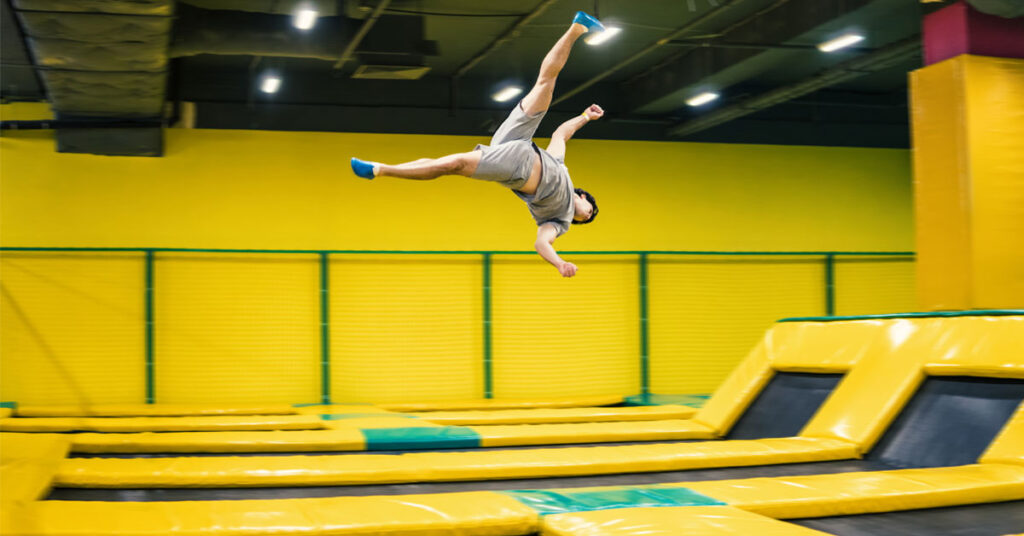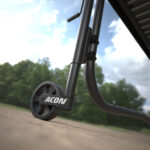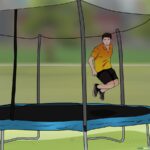Your back may hurt after trampoline jumping due to muscle strain or improper technique. Overuse during the activity can lead to discomfort or injury.
Jumping on a trampoline can be an exhilarating and fun way to exercise, but it might sometimes result in back pain. This discomfort typically stems from the stress that bouncing places on the spine and surrounding muscles. Trampoline workouts demand a significant amount of core strength to maintain stability and form.
Those not accustomed to such activity might experience muscle strain or even minor injuries. The repetitive jumping motion can also jolt the spine, potentially leading to soreness or pain, especially if pre-existing back issues are present. Engaging in warm-up exercises before hitting the trampoline and adopting correct jumping techniques can help minimize the risk of back pain. It’s important to monitor your body’s response to new exercises and consult with a healthcare professional if the pain persists.
Introduction To Trampoline Back Pain
Trampolining is fun, but sometimes it leads to back pain. This pain can puzzle many jump enthusiasts. It’s important to understand why this happens. Let’s dive into the reasons behind trampoline back pain and what you can do about it.
Popularity Of Trampoline Activities
Trampolines are not just for kids. Adults enjoy them too. They provide a great workout and are often used in fitness regimes.
- Gyms and parks are adding them.
- They are fun and engaging.
- Trampoline parks are popping up everywhere.
Common Complaints Post-trampolining
After jumping, some people report discomfort. This is what they say:
| Symptom | Frequency |
|---|---|
| Lower back pain | Often |
| Stiffness | Sometimes |
| Muscle soreness | Common |
Anatomical Considerations
Jumping on a trampoline seems like all fun and laughs until back pain enters the picture. To understand why this happens, let’s dive into the structure of the back and how it functions during high-impact activities like trampoline jumping.
Back Structure And Function
The back is a complex structure made up of bones, muscles, and ligaments.
- Spine: A series of connected bones called vertebrae.
- Discs: Cushion-like pads between the vertebrae.
- Muscles and Ligaments: Support spine and help with movement.
Bending, twisting, and bouncing put stress on this structure. The spine works hard to keep us upright and absorb shock during activities.
Impact Of Jumping On Spine Health
When we jump, our spine acts like a spring.
- We go up and the spine compresses.
- We land and the spine absorbs impact.
Too much jumping, especially with a bad form, overworks the back. This strain can lead to pain.
Muscle fatigue and disc pressure are common. The spine may not get enough time to recover, which hurts the back.
Identifying Trampoline-induced Back Pain
Joyful leaps on a trampoline can sometimes end in discomfort. It’s important to recognize when your backache is more than just tired muscles. This section helps pinpoint if trampoline activity is the culprit behind your back pain.
Symptoms To Look Out For
- Dull or sharp pain in the lower back region
- Stiffness or reduced mobility when bending or twisting
- Muscle spasms or tenderness around the back area
- Pain that persists for days after trampolining
- Any pain radiating down the legs
If you notice these symptoms, it may be time to evaluate the impact of your trampoline sessions on your spine and muscles.
Distinguishing Normal Aches From Serious Pain
Mild aches after bouncing are usually not alarming. These often go away with rest. In contrast, serious back pain:
| Normal Aches | Serious Pain |
|---|---|
| Resolve with time | Persists or worsens |
| Feels like muscle fatigue | Sharp, debilitating |
| Relieved by over-the-counter meds | Unresponsive to basic treatments |
Keep an eye on your body’s responses. Immediate pain or discomfort that deepens with activity should raise red flags.

Credit: www.bellicon.com
Common Causes Of Post-trampoline Back Pain
Exploring the joys of bouncing on a trampoline can sometimes lead to unexpected back pain. Understanding the common causes can help you jump back into fun with less risk of discomfort. Here we discuss why your back might protest after a session on the trampoline.
Improper Jumping Technique
Using the right form is key to avoiding back pain. While jumping, if your body isn’t aligned or if you land wrong, stress on your back increases. It’s like bending a paperclip back and forth – eventually, the metal weakens. Similarly, your back can suffer from incorrect movements.
Overexertion And Lack Of Fitness
Jumping beyond your fitness level can hurt your back. The muscles get tired and less able to support your spine. Think of your muscles as rubber bands. If they’re not used to stretching so far, they can get overworked. Make sure to warm up and build up your bouncing sessions gradually.
Repetitive Stress Injury And Overuse
Just like typing at a keyboard all day can strain your wrists, jumping repeatedly can strain your back. Each bounce puts pressure on your spine. Over time, too much jumping without proper rest can lead to pain. It’s crucial to give your back time to recover after trampoline fun.
Preventive Measures And Safety Tips
Trampolines can offer hours of fun and exercise. But, jumping can hurt your back. Back pain should not stop the fun. Learn how to jump without the ouch. Follow these tips to keep your back happy and healthy.
Proper Warm-up And Cool-down Exercises
Before jumping, warm up. This gets your muscles ready. It can prevent injuries too. After jumping, cool down. This helps your muscles relax. Follow these exercises for a safe trampoline experience.
- Stretch your back and legs. This keeps them flexible.
- Gentle jumping jacks. They get your heart rate up.
- For cooling down, walk in place. It lowers your heart rate slowly.
- Touch your toes. It stretches your back and hamstrings.
Safe Jumping Techniques
Bounce safely. Always control your jumps. Stay in the middle of the trampoline. This is the safest spot. Use these tips for a safer bounce:
- Keep your knees slightly bent.
- Do not attempt flips or twists if you’re not trained.
- Landing on both feet helps balance and prevents strain.
Using Trampolines With Adequate Safety Features
Choose trampolines with safety in mind. These features are a must:
- Safety netting: It stops you from falling off.
- Padding: This cushions the frame and springs.
- Ensure a sturdy frame. It should not wobble or tip.
Remember, always check your trampoline before use. Fix any issues like tears or loose springs. This can keep everyone safe. Enjoy your jump!
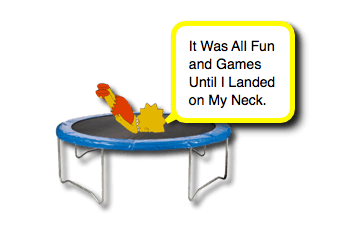
Credit: pedemmorsels.com
Treatment And Recovery Strategies
Experiencing back pain after trampoline jumping is not uncommon. The spine endures considerable stress during this high-impact activity. Proper treatment and recovery strategies ensure a safe return to all the fun. Here, we’ll explore a range of effective approaches to manage and alleviate back pain stemming from trampoline use.
Home Remedies For Mild Back Pain
Before diving into medications and doctor visits, consider simple home remedies that might soothe your back pain:
- Rest: Take a break from strenuous activities. Rest aids the body’s natural healing process.
- Ice Packs: Apply ice to reduce inflammation for the first 48 hours, then switch to heat.
- Heat Therapy: After two days, heat applications can encourage blood flow and healing.
- Over-the-Counter Pain Relievers: Medications like ibuprofen can alleviate pain and swelling.
- Gentle Stretching: Simple stretches can loosen tight muscles without overexerting the back.
When To Seek Professional Medical Help
Some cases require a doctor’s intervention. Look for signs like these:
- Persistent Pain: Pain that doesn’t improve with home treatment after a few days.
- Severe Discomfort: Intense pain that impairs daily functioning or rest.
- Neurological Symptoms: Numbness, tingling, or weakness in the limbs.
If you notice any of these symptoms, contact a healthcare provider without delay. Early diagnosis often leads to more effective treatment.
Rehabilitation Exercises And Physical Therapy
Physical therapy can be crucial for recovery. It includes exercises designed to:
- Strengthen the back muscles.
- Enhance flexibility.
- Reduce pain.
- Prevent future injury.
A tailored exercise program, often created with the help of a physical therapist, restores function and mobility. Follow the regimen closely for optimal results.
Long-term Considerations For Trampoline Enthusiasts
Long-Term Considerations for Trampoline Enthusiasts spark a vital discussion on maintaining back health. People jumping on trampolines often overlook the impact on their backs over time. Chronic back pain can take the leap out of your fun. Let’s explore how you can bounce back after trampoline back pain and keep yourself safe in the long run.
Incorporating Cross-training And Strengthening
Bouncing on a trampoline is a full-body workout. Your back muscles are essential in this activity. Strong back and core muscles support your spine. Cross-training introduces various exercises to your routine. This builds muscle strength evenly. Consider these exercises to support your trampoline activities:
- Pilates: Enhances core strength and spinal alignment.
- Yoga: Increases flexibility and reduces muscle tension.
- Swimming: Builds endurance without straining the spine.
Combine these activities with your trampoline sessions for a healthier back!
Understanding The Risks Of Chronic Injury
Repeated stress on your spine from trampoline jumping can lead to chronic back injuries. The spine absorbs shock each time you land. Over time, this can cause wear and tear. It’s crucial to know the signs of injury:
| Sign | Description |
|---|---|
| Sharp pain: | Indicates a possible muscle strain or disc issue. |
| Stiffness: | Suggests muscle fatigue or the onset of chronic issues. |
| Numbness: | May signal nerve compression or more serious injury. |
Understanding these risks ensures early detection and prevention.
Balancing Fun With Health Considerations
Trampolining is not just about the thrill. It is also about balancing this high-energy activity with health considerations. Maintain a routine that protects your back:
- Warm-Up: Always prepare your body with stretches.
- Rest Periods: Allow your muscles time to recover between sessions.
- Proper Technique: Use the correct form to reduce injury risk.
Balancing fun and health helps you enjoy trampolining without back pain.
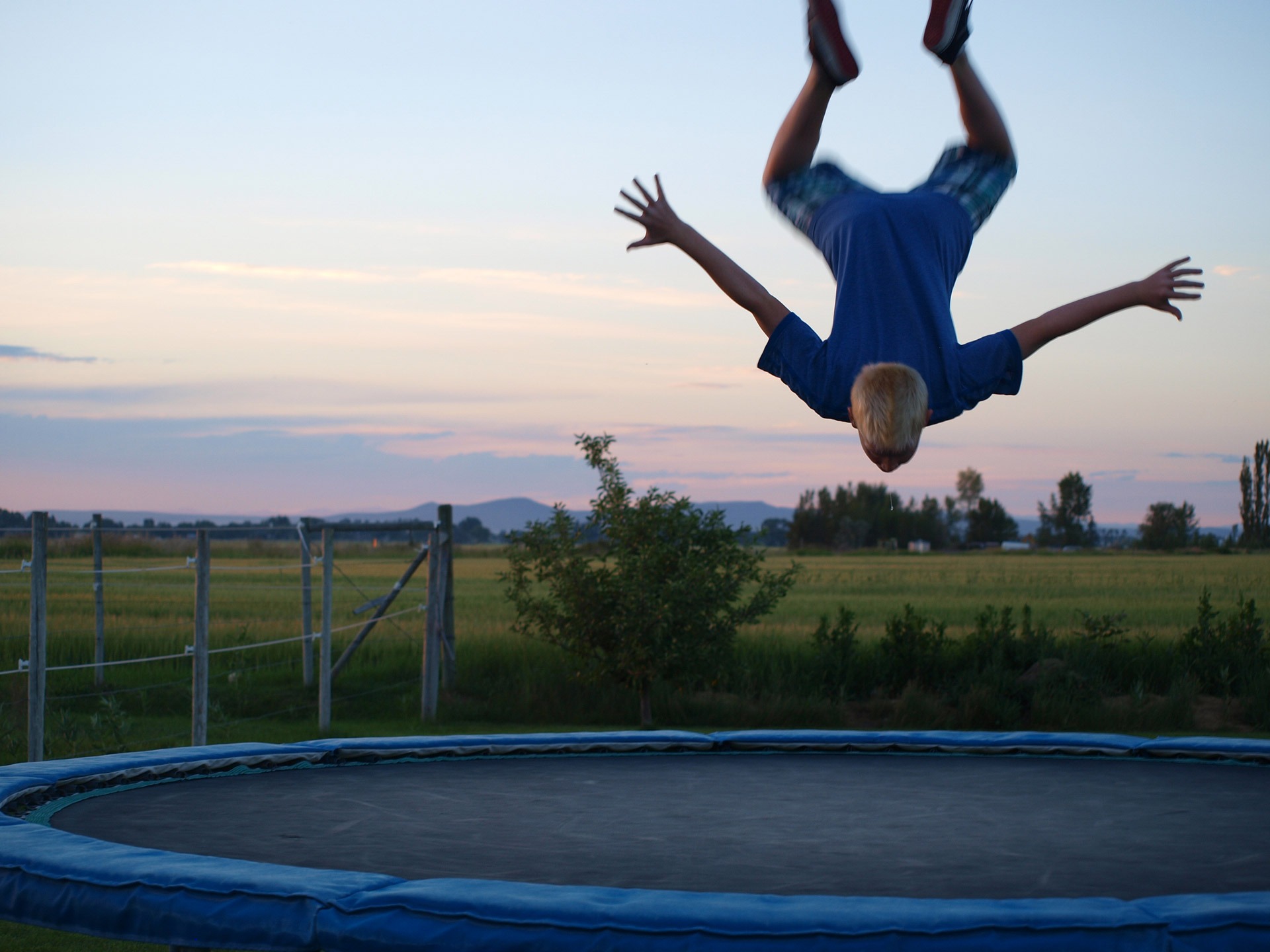
Credit: pedimom.com
Frequently Asked Questions On Trampoline Back Pain: Why Does My Back Hurt After Jumping On A Trampoline?
Why Does Trampoline Jumping Cause Back Pain?
Trampoline jumping can lead to back pain due to improper landing, repetitive strain on back muscles, and spinal compression. Incorrect posture while jumping or weak core muscles may exacerbate the strain, causing discomfort or pain in the back.
Can Trampolines Help In Strengthening My Back?
Yes, when used correctly, trampolines can help strengthen back muscles. Rebounding exercise on a trampoline can improve core strength and stability. However, it’s important to perform exercises with proper form to prevent injury and strain on the back.
What Is The Best Way To Avoid Back Pain On A Trampoline?
To avoid back pain on a trampoline, maintain proper jumping technique by keeping your core engaged and back straight. Gradually increase intensity, warm up before exercising, and avoid high-risk moves without proper training and strength.
Are There Stretches To Prevent Back Pain After Trampolining?
There are stretches that can help prevent back pain after using a trampoline. Focus on stretches that target the lower back and core muscles, such as spinal twists, hip flexor stretches, and gentle back extensions to aid in recovery and flexibility.
Conclusion
Jumping on a trampoline can be exhilarating, but back pain afterwards signals caution. This discomfort might stem from improper form, overexertion, or pre-existing issues. Maintaining core strength and practicing good technique are crucial for a pain-free experience. Seek professional advice if pain persists, ensuring your trampoline fun isn’t bounced away by injury.
Remember, your back’s health must always come first.
